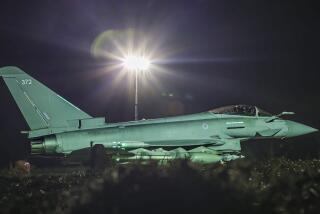U.S.-Kurd Forces Mobilize for Battle
- Share via
HALABJA, Iraq — As artillery fire rumbled through the canyons, scores of U.S. forces fanned through northeastern Iraq on Sunday in preparation for an attack on an Islamic militant group that controls a sliver of mountainous territory along the Iranian border.
A convoy of three buses and three trucks carrying at least 75 soldiers navigated dirt roads on its way toward Halabja, where 7,000 U.S.-backed Kurdish fighters have been mobilized to attack Ansar al Islam, which the Bush administration has deemed a terrorist organization.
The U.S. soldiers are part of a contingent of 200 troops that landed in four transport planes at an airstrip near Sulaymaniyah on Saturday night, making it the largest single deployment in the north since the war began. In all, there are about 500 U.S. troops and intelligence operatives in the eastern half of the Kurdish enclave in northern Iraq.
A senior Kurdish official said Kurdish units supported by American ground forces will strike Ansar’s 500 to 700 guerrillas in the coming days.
The impending attack is part of a broader U.S. plan to secure crucial areas of northern Iraq and protect the autonomous Kurdish region from Saddam Hussein, whose military campaigns have killed more than 180,000 Kurds, including 5,000 who perished in Halabja in a chemical weapons attack in March 1988.
On Sunday, U.S. forces were also spotted in Irbil and Salahuddin as the northern front -- constricted by Turkey’s refusal to allow American forces to cross its border with Iraq -- takes shape in a much smaller version than originally planned.
The scene around Halabja was tense as hundreds of Kurdish fighters carrying blankets, radios and ammunition gathered at checkpoints. Artillery boomed at 4:30 p.m. as Kurds fired 30 shells at Ansar strongholds beneath a mountain snow line about 10 miles away. About a half-hour later, the U.S. convoy of buses and trucks rolled into the city.
“We think war is getting closer,” said Fakradin Abdullah Hama Said, a military spokesman for the Patriotic Union of Kurdistan, which governs the eastern portion of the autonomous Kurdish enclave.
A Western diplomat familiar with the U.S. military said an assault on Ansar may include between 200 and 400 Special Forces soldiers backed by helicopter gunships.
“The bigger the size of the U.S. troops, the better for us,” said Mustafa Said Qadir, the PUK military commander.
In recent days, the U.S. has fired about 60 Tomahawk cruise missiles at Ansar targets. The strikes have killed and wounded 100 to 150 Islamic fighters, according to Kurdish officials. The ground battle will be tricky. Ansar knows the caves and canyons in the region and is attempting to recruit members from a more moderate Muslim group, Komaly Islami.
“We have told Komaly to stay away from Ansar, both geographically and politically,” said Barham Salih, the PUK prime minister. “They, regrettably, did not heed the advice.”
There were indications that some Komaly fighters have already joined Ansar.
Kurdish military officials, eavesdropping on Ansar radio chatter, say the guerrillas have made three car bombs. An Ansar car bomb on Saturday killed five people, including an Australian journalist.
“Last night during the U.S. bombing, Ansar was scared we would attack them,” Hama Said, the PUK’s military spokesman, said Sunday. “We know they are psychologically very bad off. Their morale is low.”
Kurdish fighters, though, are poorly equipped, especially when compared with their American counterparts. Washington promised the Kurds ammunition and other supplies, but Turkey has refused to allow shipments to cross the border, leaving the typical Kurdish soldier -- wearing tennis shoes or ripped boots -- with little more than a Kalashnikov rifle bought in the black market and a few magazines of bullets.
For many ordinary Kurds, the arrival of U.S. soldiers, whom they call “special guests,” has been a gleeful occasion. News that four U.S. planes landed over the weekend just beyond a refugee camp here sent a buzz through this city as people turned out and waved to an American convoy.
“This is the best news,” said one shopkeeper. “This is so good. I am happy.”
More to Read
Sign up for Essential California
The most important California stories and recommendations in your inbox every morning.
You may occasionally receive promotional content from the Los Angeles Times.













